Kürsat Petek
Label-Efficient LiDAR Panoptic Segmentation
Mar 04, 2025



Abstract:A main bottleneck of learning-based robotic scene understanding methods is the heavy reliance on extensive annotated training data, which often limits their generalization ability. In LiDAR panoptic segmentation, this challenge becomes even more pronounced due to the need to simultaneously address both semantic and instance segmentation from complex, high-dimensional point cloud data. In this work, we address the challenge of LiDAR panoptic segmentation with very few labeled samples by leveraging recent advances in label-efficient vision panoptic segmentation. To this end, we propose a novel method, Limited-Label LiDAR Panoptic Segmentation (L3PS), which requires only a minimal amount of labeled data. Our approach first utilizes a label-efficient 2D network to generate panoptic pseudo-labels from a small set of annotated images, which are subsequently projected onto point clouds. We then introduce a novel 3D refinement module that capitalizes on the geometric properties of point clouds. By incorporating clustering techniques, sequential scan accumulation, and ground point separation, this module significantly enhances the accuracy of the pseudo-labels, improving segmentation quality by up to +10.6 PQ and +7.9 mIoU. We demonstrate that these refined pseudo-labels can be used to effectively train off-the-shelf LiDAR segmentation networks. Through extensive experiments, we show that L3PS not only outperforms existing methods but also substantially reduces the annotation burden. We release the code of our work at https://l3ps.cs.uni-freiburg.de.
A Good Foundation is Worth Many Labels: Label-Efficient Panoptic Segmentation
May 29, 2024Abstract:A key challenge for the widespread application of learning-based models for robotic perception is to significantly reduce the required amount of annotated training data while achieving accurate predictions. This is essential not only to decrease operating costs but also to speed up deployment time. In this work, we address this challenge for PAnoptic SegmenTation with fEw Labels (PASTEL) by exploiting the groundwork paved by visual foundation models. We leverage descriptive image features from such a model to train two lightweight network heads for semantic segmentation and object boundary detection, using very few annotated training samples. We then merge their predictions via a novel fusion module that yields panoptic maps based on normalized cut. To further enhance the performance, we utilize self-training on unlabeled images selected by a feature-driven similarity scheme. We underline the relevance of our approach by employing PASTEL to important robot perception use cases from autonomous driving and agricultural robotics. In extensive experiments, we demonstrate that PASTEL significantly outperforms previous methods for label-efficient segmentation even when using fewer annotations. The code of our work is publicly available at http://pastel.cs.uni-freiburg.de.
LetsMap: Unsupervised Representation Learning for Semantic BEV Mapping
May 29, 2024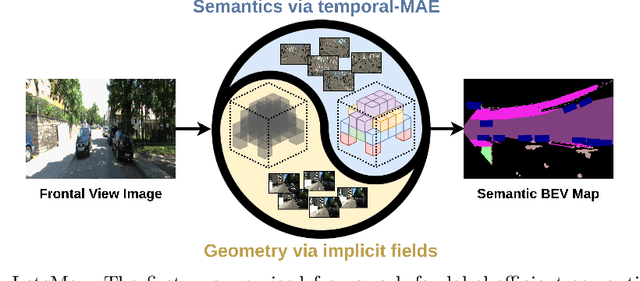

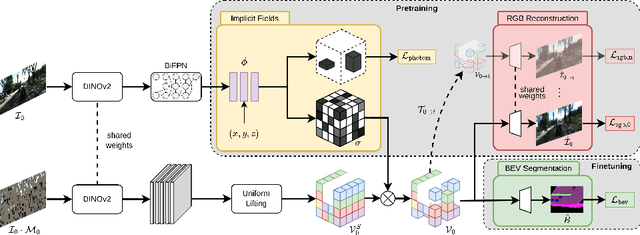

Abstract:Semantic Bird's Eye View (BEV) maps offer a rich representation with strong occlusion reasoning for various decision making tasks in autonomous driving. However, most BEV mapping approaches employ a fully supervised learning paradigm that relies on large amounts of human-annotated BEV ground truth data. In this work, we address this limitation by proposing the first unsupervised representation learning approach to generate semantic BEV maps from a monocular frontal view (FV) image in a label-efficient manner. Our approach pretrains the network to independently reason about scene geometry and scene semantics using two disjoint neural pathways in an unsupervised manner and then finetunes it for the task of semantic BEV mapping using only a small fraction of labels in the BEV. We achieve label-free pretraining by exploiting spatial and temporal consistency of FV images to learn scene geometry while relying on a novel temporal masked autoencoder formulation to encode the scene representation. Extensive evaluations on the KITTI-360 and nuScenes datasets demonstrate that our approach performs on par with the existing state-of-the-art approaches while using only 1% of BEV labels and no additional labeled data.
Automatic Target-Less Camera-LiDAR Calibration From Motion and Deep Point Correspondences
Apr 26, 2024



Abstract:Sensor setups of robotic platforms commonly include both camera and LiDAR as they provide complementary information. However, fusing these two modalities typically requires a highly accurate calibration between them. In this paper, we propose MDPCalib which is a novel method for camera-LiDAR calibration that requires neither human supervision nor any specific target objects. Instead, we utilize sensor motion estimates from visual and LiDAR odometry as well as deep learning-based 2D-pixel-to-3D-point correspondences that are obtained without in-domain retraining. We represent the camera-LiDAR calibration as a graph optimization problem and minimize the costs induced by constraints from sensor motion and point correspondences. In extensive experiments, we demonstrate that our approach yields highly accurate extrinsic calibration parameters and is robust to random initialization. Additionally, our approach generalizes to a wide range of sensor setups, which we demonstrate by employing it on various robotic platforms including a self-driving perception car, a quadruped robot, and a UAV. To make our calibration method publicly accessible, we release the code on our project website at http://calibration.cs.uni-freiburg.de.
BEVCar: Camera-Radar Fusion for BEV Map and Object Segmentation
Mar 18, 2024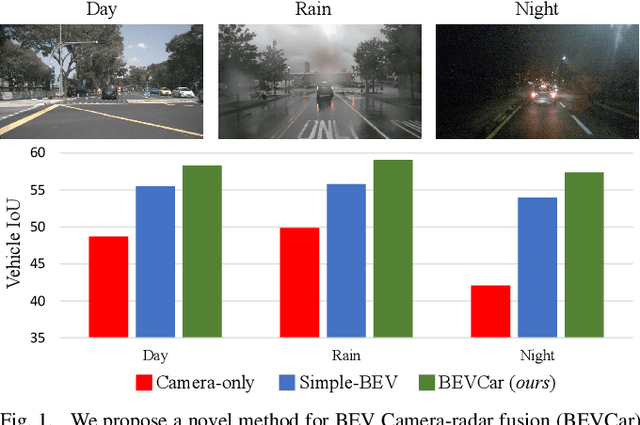
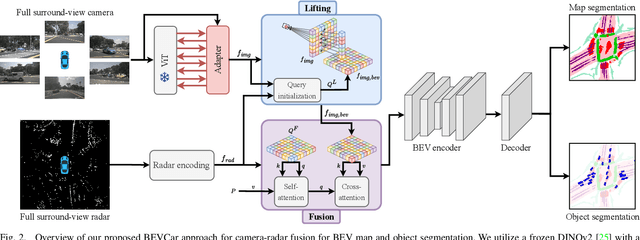
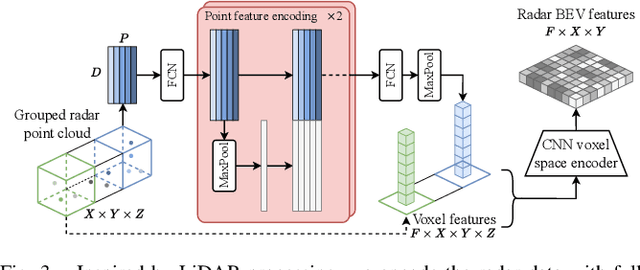
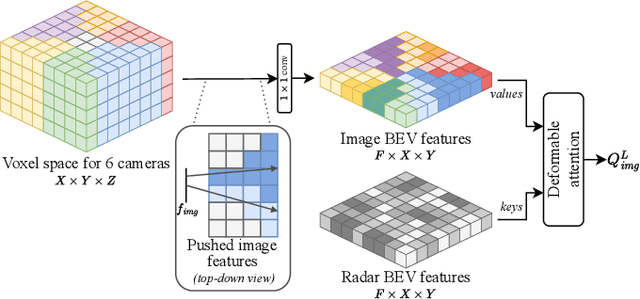
Abstract:Semantic scene segmentation from a bird's-eye-view (BEV) perspective plays a crucial role in facilitating planning and decision-making for mobile robots. Although recent vision-only methods have demonstrated notable advancements in performance, they often struggle under adverse illumination conditions such as rain or nighttime. While active sensors offer a solution to this challenge, the prohibitively high cost of LiDARs remains a limiting factor. Fusing camera data with automotive radars poses a more inexpensive alternative but has received less attention in prior research. In this work, we aim to advance this promising avenue by introducing BEVCar, a novel approach for joint BEV object and map segmentation. The core novelty of our approach lies in first learning a point-based encoding of raw radar data, which is then leveraged to efficiently initialize the lifting of image features into the BEV space. We perform extensive experiments on the nuScenes dataset and demonstrate that BEVCar outperforms the current state of the art. Moreover, we show that incorporating radar information significantly enhances robustness in challenging environmental conditions and improves segmentation performance for distant objects. To foster future research, we provide the weather split of the nuScenes dataset used in our experiments, along with our code and trained models at http://bevcar.cs.uni-freiburg.de.
Panoptic Out-of-Distribution Segmentation
Oct 18, 2023



Abstract:Deep learning has led to remarkable strides in scene understanding with panoptic segmentation emerging as a key holistic scene interpretation task. However, the performance of panoptic segmentation is severely impacted in the presence of out-of-distribution (OOD) objects i.e. categories of objects that deviate from the training distribution. To overcome this limitation, we propose Panoptic Out-of Distribution Segmentation for joint pixel-level semantic in-distribution and out-of-distribution classification with instance prediction. We extend two established panoptic segmentation benchmarks, Cityscapes and BDD100K, with out-of-distribution instance segmentation annotations, propose suitable evaluation metrics, and present multiple strong baselines. Importantly, we propose the novel PoDS architecture with a shared backbone, an OOD contextual module for learning global and local OOD object cues, and dual symmetrical decoders with task-specific heads that employ our alignment-mismatch strategy for better OOD generalization. Combined with our data augmentation strategy, this approach facilitates progressive learning of out-of-distribution objects while maintaining in-distribution performance. We perform extensive evaluations that demonstrate that our proposed PoDS network effectively addresses the main challenges and substantially outperforms the baselines. We make the dataset, code, and trained models publicly available at http://pods.cs.uni-freiburg.de.
Few-Shot Panoptic Segmentation With Foundation Models
Sep 19, 2023Abstract:Current state-of-the-art methods for panoptic segmentation require an immense amount of annotated training data that is both arduous and expensive to obtain posing a significant challenge for their widespread adoption. Concurrently, recent breakthroughs in visual representation learning have sparked a paradigm shift leading to the advent of large foundation models that can be trained with completely unlabeled images. In this work, we propose to leverage such task-agnostic image features to enable few-shot panoptic segmentation by presenting Segmenting Panoptic Information with Nearly 0 labels (SPINO). In detail, our method combines a DINOv2 backbone with lightweight network heads for semantic segmentation and boundary estimation. We show that our approach, albeit being trained with only ten annotated images, predicts high-quality pseudo-labels that can be used with any existing panoptic segmentation method. Notably, we demonstrate that SPINO achieves competitive results compared to fully supervised baselines while using less than 0.3% of the ground truth labels, paving the way for learning complex visual recognition tasks leveraging foundation models. To illustrate its general applicability, we further deploy SPINO on real-world robotic vision systems for both outdoor and indoor environments. To foster future research, we make the code and trained models publicly available at http://spino.cs.uni-freiburg.de.
CoDEPS: Online Continual Learning for Depth Estimation and Panoptic Segmentation
Mar 17, 2023Abstract:Operating a robot in the open world requires a high level of robustness with respect to previously unseen environments. Optimally, the robot is able to adapt by itself to new conditions without human supervision, e.g., automatically adjusting its perception system to changing lighting conditions. In this work, we address the task of continual learning for deep learning-based monocular depth estimation and panoptic segmentation in new environments in an online manner. We introduce CoDEPS to perform continual learning involving multiple real-world domains while mitigating catastrophic forgetting by leveraging experience replay. In particular, we propose a novel domain-mixing strategy to generate pseudo-labels to adapt panoptic segmentation. Furthermore, we explicitly address the limited storage capacity of robotic systems by proposing sampling strategies for constructing a fixed-size replay buffer based on rare semantic class sampling and image diversity. We perform extensive evaluations of CoDEPS on various real-world datasets demonstrating that it successfully adapts to unseen environments without sacrificing performance on previous domains while achieving state-of-the-art results. The code of our work is publicly available at http://codeps.cs.uni-freiburg.de.
SkyEye: Self-Supervised Bird's-Eye-View Semantic Mapping Using Monocular Frontal View Images
Feb 08, 2023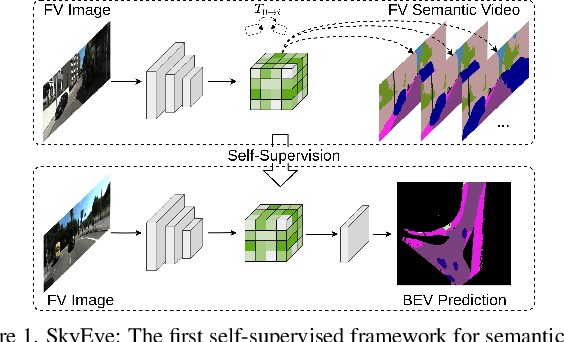



Abstract:Bird's-Eye-View (BEV) semantic maps have become an essential component of automated driving pipelines due to the rich representation they provide for decision-making tasks. However, existing approaches for generating these maps still follow a fully supervised training paradigm and hence rely on large amounts of annotated BEV data. In this work, we address this limitation by proposing the first self-supervised approach for generating a BEV semantic map using a single monocular image from the frontal view (FV). During training, we overcome the need for BEV ground truth annotations by leveraging the more easily available FV semantic annotations of video sequences. Thus, we propose the SkyEye architecture that learns based on two modes of self-supervision, namely, implicit supervision and explicit supervision. Implicit supervision trains the model by enforcing spatial consistency of the scene over time based on FV semantic sequences, while explicit supervision exploits BEV pseudolabels generated from FV semantic annotations and self-supervised depth estimates. Extensive evaluations on the KITTI-360 dataset demonstrate that our self-supervised approach performs on par with the state-of-the-art fully supervised methods and achieves competitive results using only 1% of direct supervision in the BEV compared to fully supervised approaches. Finally, we publicly release both our code and the BEV datasets generated from the KITTI-360 and Waymo datasets.
Robust Monocular Localization in Sparse HD Maps Leveraging Multi-Task Uncertainty Estimation
Oct 20, 2021
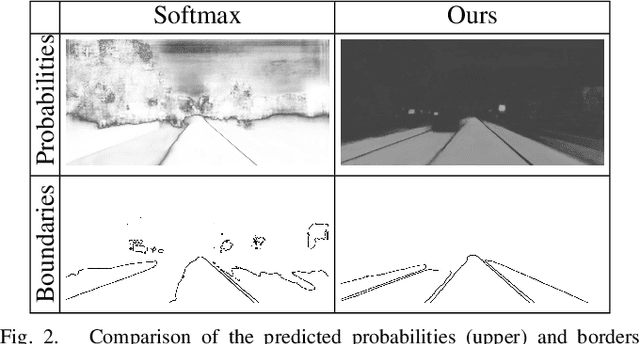

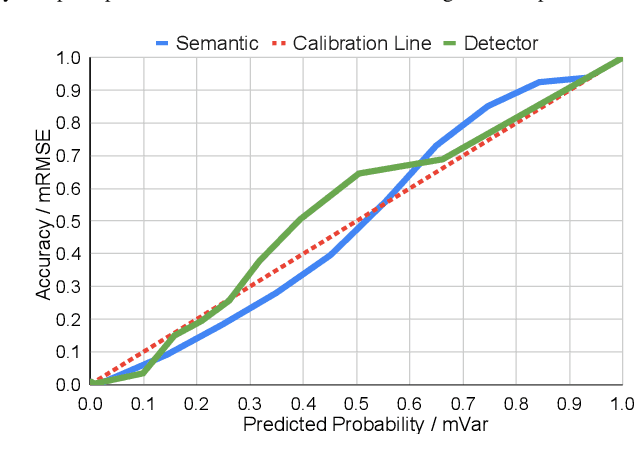
Abstract:Robust localization in dense urban scenarios using a low-cost sensor setup and sparse HD maps is highly relevant for the current advances in autonomous driving, but remains a challenging topic in research. We present a novel monocular localization approach based on a sliding-window pose graph that leverages predicted uncertainties for increased precision and robustness against challenging scenarios and per frame failures. To this end, we propose an efficient multi-task uncertainty-aware perception module, which covers semantic segmentation, as well as bounding box detection, to enable the localization of vehicles in sparse maps, containing only lane borders and traffic lights. Further, we design differentiable cost maps that are directly generated from the estimated uncertainties. This opens up the possibility to minimize the reprojection loss of amorphous map elements in an association free and uncertainty-aware manner. Extensive evaluation on the Lyft 5 dataset shows that, despite the sparsity of the map, our approach enables robust and accurate 6D localization in challenging urban scenarios
 Add to Chrome
Add to Chrome Add to Firefox
Add to Firefox Add to Edge
Add to Edge